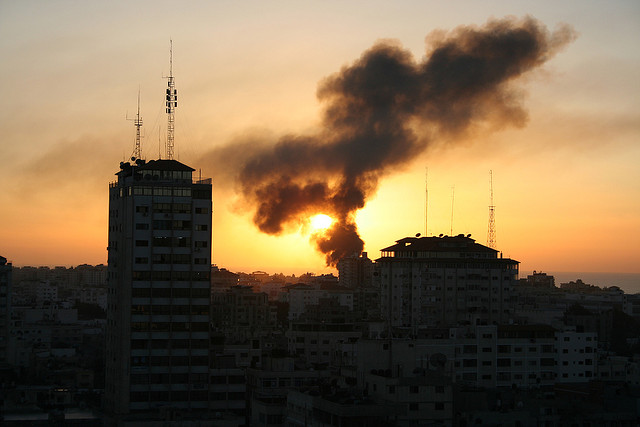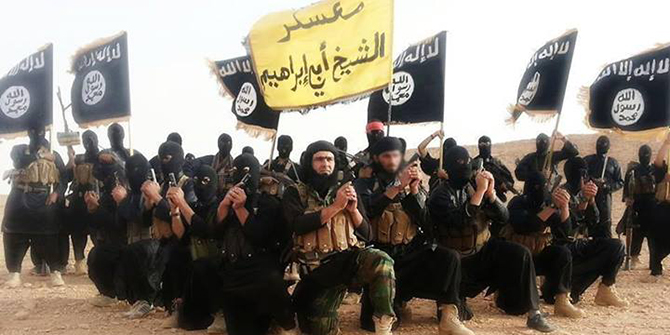By Megan Schmidt
This is the second post in our symposium on Palestine, Israel and the Responsibility to Protect. Megan Schmidt is a Senior Program Officer at the International Coalition for the Responsibility to Protect.

The present conflict in Gaza between Israel and Hamas has revived the complex debate on the applicability of the Responsibility to Protect (R2P) to this crisis. The central questions that make the norm’s relevance murky are: What is the status of Gaza? What entities have governing authority over and responsibility for the people of Gaza? And what does said governing mean in practice?
Such questions are important because R2P is first and foremost a political commitment and obligation of states to protect their own populations. The issue of governing authority over Gaza is one of great complexity with arguments to support views on all sides, showing the many grey areas that exist. This article in no way attempts to make a clear determination on the status of the territory or who holds governing authority, but rather seeks to present if and how R2P could or could not apply to the present crisis based on the stance one takes over Gaza’s status. Still, R2P’s applicability in this crisis, or any situation for that matter, does not trump the legal obligations parties already have, including those under international humanitarian law (IHL) and customary international law. Rather, R2P’s application could provide an additional framework for understanding the crisis, as well as an additional tool for advocacy by actors seeking to prioritise civilian protection.
What does the Responsibility to Protect entail and who has this obligation?
In the 2005 UN World Summit Outcome Document, heads of state and governments made a historic commitment to protect their populations from genocide, war crimes, crimes against humanity, and ethnic cleansing. In addition to the primary responsibility of the state to prevent these crimes, including their incitement, R2P places an obligation on the international community to assist states in building their capacity for prevention. Should a state be unable or unwilling to protect their populations, or is in fact perpetrating the crimes itself, the international community has a responsibility to take timely and decisive action using a range of non-coercive and coercive measures, including force (as a last resort and only when authorised by the United Nations Security Council).
As the UN Secretary-General has stated, the emerging norm is narrow but deep – narrow in its limited scope to the four crimes and violations, but deep in the tools available for prevention and response. While not legally binding itself, R2P is grounded in existing legal doctrine and normative frameworks, with its added value resting in the re-framing of state sovereignty as not solely entailing the rights of the state but also its obligations to protect its people.
A last point critical in setting the stage for the discussion on Gaza and R2P is the norm’s relationship with international humanitarian law (IHL) – or the law of war. Rooted in international treaties and conventions, IHL sets out the legal obligations to parties in an armed conflict regardless of if that conflict is between states or happening internally, with violations of IHL amounting to war crimes. Such obligations are to protect civilians, as well as prisoners of war, the wounded or sick, and medical and religious personnel, among others. In addition to the protection of civilians, IHL sets out legal obligations to protect objects and infrastructure, including hospitals, cultural property, and ambulances. It also articulates the illegality of targeting infrastructure for the survival of the civilian population, such as water supplies. While mass atrocity crimes frequently occur during conflict, there are distinct differences with regards to scope and applicability of IHL and R2P. As stated earlier, the norm’s focus is restricted solely to the four crimes and violations and such atrocities can be committed in and outside of conflict, with IHL not applying to the latter. Additionally, while R2P includes war crimes as one of the four crimes and violations from which states are obligated to protect their populations, such crimes within the norm’s scope are limited to those directed against civilian populations and committed in a widespread and systematic manner. As such, crises will arise where IHL and R2P will both be applicable, but there will also be those in which R2P will not be relevant due to the nature of the conflict. This brings us to the question of the present crisis in Gaza.
The Question of Gaza’s status and R2P
Central to understanding R2P’s applicability in this present crisis is the question of Gaza’s standing as either an occupied or independent entity. This is in no way a clear-cut issue, and not one that this article seeks to determine. But what can be assessed is how the norm of the Responsibility to Protect could apply if one were to view the territory as occupied or not. A recent analysis by the International Coalition for the Responsibility to Protect reflects on the question of status and what this would mean for the obligations of parties involved.
To start, let us explore the argument of if Gaza were not considered an occupied territory. This position stems from the fact that, in 2005, Israel undertook a disengagement plan in which, some would argue, the state relinquished its occupation of Gaza. The territory was then seized by Hamas, which declared its authority as the governing entity. If one were to view Hamas as the governing authority, then under R2P, Hamas would have the obligation to protect its populations within its borders from the commission of the four crimes and violations, a responsibility that would also exist for Israel with regards to its populations residing within its territory. Such obligations would not, however, carry over into an inter-state crisis. As the ICRtoP states:
While both governing bodies would have the obligation under the Responsibility to Protect to prevent the commission of atrocity crimes within their borders, RtoP would not be applicable for the protection of civilians across borders in the crisis. IHL and the protection of civilians framework would be applicable in this context, legally obligating all parties to the conflict to ensure that civilians are not indiscriminately targeted or impacted.
Those obligations under IHL and customary law would place a range of legal restrictions on the actions of all parties to the conflict and include protections for populations from atrocity crimes, as well as from other violations.
The applicability of R2P, however, would be drastically different if it was found that Gaza was an occupied territory under Israeli authority, a view that some in the international community, including NGOs, governments and UN actors and bodies hold. With regards to this point, the Coalition provided clarity on the applicability, stating that:
If one accepts the status of Gaza as an occupied territory, the Responsibility to Protect the populations of Gaza would fall between both the Occupying Power, Israel, and the de facto authority, Hamas. The degree to which each has the responsibility to protect populations in Gaza would be determined by the test of ‘effective control;’ namely, the extent of the capacity of each party to implement a particular measure to protect civilians.
What role is there for the international community & what happens now?
If it were to be determined that R2P applies, then in accordance with the obligations articulated in the 2005 World Summit Document and subsequent reports of the United Nations Secretary-General, the vast array of actors encompassing the international community would have available non-coercive and coercive measures to take action, should a state be unable or unwilling to protect its populations, or is perpetrating the crimes against its people. These measures would include undertaking public and private persuasion, supporting and facilitating a humanitarian cease-fire and/or resolution to the crisis, establishing a Commission of Inquiry to investigate the situation, providing humanitarian service delivery, and authorising the use of force through the UN Security Council, among many others. Any measures would have to prioritise the protection needs of the population and their implementation would vary on a case-by-case basis, depending upon the context of the situation, as well as the myriad of issues impacting political decision-making. The obvious issue, however, is the political will of some actors within the international community to implement stronger measures to protect civilians on all sides. This challenge is not one that would solely impact action under R2P, but remains an issue in this crisis more broadly, whether it is in the name of atrocities prevention or civilian protection.
Regardless of whether R2P applies or not, the suffering of the people of Gaza and Israel continues. The death toll increases by the day, clearly showing that a resolution to the crisis that ensures their safety must be prioritised. It is now for the parties to the conflict and global actors to address the immediate and long-term issues plaguing the region. Unfortunately, the latter goal is one that will continue to face the international community and the people of Palestine and Israel for years to come.
Other contributions to this symposium, include:
- Both Israel and Hamas have a Responsibility to Protect Civilians, by Simon Adams
- R2P Isn’t a Useful Framework for Gaza – or Anything, by David Rieff
- Gaza and Israel – A Case for International Humanitarian Law, Not R2P, by James P. Rudolph
- In Palestine, R2P Isn’t Dead. It Could Never Have Existed, by Michael Kearney
- ‘Is Gaza in Israel?’ R2P and Inter-State Crises, by Aidan Hehir






1 Comments